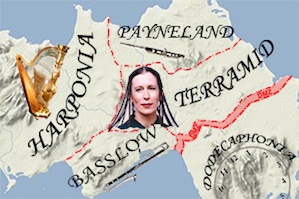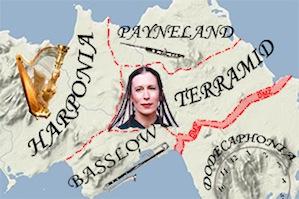The music was all over the map Sunday afternoon at Davies Symphony Hall, but the performers focused only on the highest peak of performance for the last concert of the San Francisco Symphony’s American Mavericks series. Members of the Symphony premiered Meredith Monk’s Realm Variations, a recent commission, and three pieces from the decade 1963–1973 by Lukas Foss, David Del Tredici, and Steve Reich. Monk’s and Reich’s compositions provoked the warmest audience responses, yet the terrific renditions of Foss’ and Del Tredici’s more problematic works did not go unrecognized.

The concert opened with Reich’s 1973 Music for Pieces of Wood. No, untrained beachcombers waving random finds will not do for this highly disciplined and mesmerizing classic from the heyday of minimalism. You have to love to count precisely, and rap together two tuned claves more than a thousand times over 11 minutes, with the option to do it longer if you like. Two players have the thankless job of each rapping his own pattern repeatedly, while three others take turns introducing new sets of patterns. Each new pattern-set consists of a sequence of cells repeated a performer-chosen number of times; then the other two “introducers” repeat the pattern set with delayed entries, like in a canon. All the patterns are lively and infectious, and it’s fun to figure out the methodology and anticipate what comes next. The expertise of the Symphony’s percussion section accounted for the great success of this number with the audience.
Next came Monk’s work, designed to show off the skill of Catherine Payne on piccolo. The “realm” of the title refers to the exploration of pitch regions: high for piccolo, middle for viola and horn, low for contrabass clarinet and bassoon. Three pairs of wordless voices of comparable ranges join the ensemble, while a harp acts as a go-between touching all three regions.
Singing the Piccolo, Playing the Voice

As James M. Keller related in his excellent program notes, Monk was interested in how instruments can sound like voices and vice versa. She had known that Payne “can really sing” with her piccolo, and how her instrument can suggest a geographic quality and “extend into a performance space.”
Accordingly, Realm Variations began with Payne intoning a wistful pastorale for a couple of minutes, at times recalling, at a higher pitch, the shepherd’s lament in Act 3 of Wagner’s opera Tristan and Isolde. Attention then shifted to a stunningly evocative combination of low notes on contrabass clarinet and harp, joined soon by bassoon and low male voices. Over time, the three “realms” introduced themselves, began to interact, and continued the relaxed and nostalgic mood. About halfway into the 22-minute composition, the voices occasionally, and deliberately, slid in and out of pitch, with marvelous effect. As a whole, Realm’s interplay remained thoroughly engaging. Even though its experience built no cathedrals, wounds were healed.
Related Article
Cheers for Mavericks: Innovative Transmissions, Wizardry, and Jest
March 15, 2012
Mavericks Festival Starts With a Triumph
March 8, 2012
The result was enjoyable to watch, though undistinguished and dated in sound. Percussionist Jack Van Geem leapt about like a marionette, hitting his wide array of instruments, which included a garbage-can lid. Meanwhile, clarinetist Carey Bell wandered about as if he were Till Eulenspiegel making trouble, blowing into Jeremy Denk’s piano and over Van Geem’s drums. Denk had to keep a 12-tone, breakneck pizzicato line going for bar after bar.
The highlight came in the third section of Echoi, where a repeated interval of a minor third in Peter Wyrick’s cello shone as the only readily accessible tune of the collection.
MTT’s map of musical mavericks has been outstanding this year for the quality of new works performed.
Music Director Michael Tilson Thomas emerged to conduct the final number, Del Tredici’s 1966 Syzygy for a chamber orchestra of 20 musicians and (amplified) coloratura soprano. Before Del Tredici became a true maverick relative to contemporaries with a series of hyper-romantic tonal works, he was a member of the 1960s 12-tone/serial herd, as illustrated by this concert’s setting of two poems (“Ecce Puer” and “Nightpiece”) by James Joyce. A chief characteristic of his later music — a freeride of wild and wide-ranging soloist lines — is present in spades in Syzygy, and soprano Kiera Duffy trumped them all with her astounding mountain bike of a voice. At times, the amplification was a bit too steep, and I had to cover my ears.
One thing to say in favor of this early Del Tredici work is its relative concision, compared to the excesses of some of his later endeavors. Joyce’s words, when identifiable (they were often deliberately distorted by Del Tredici’s pyrotechnic writing, not by any lack of clarity on Duffy’s part), were beautiful to apprehend, at some times because of, and other times in spite of, what was heard on stage.
MTT’s map of musical mavericks has been outstanding this year for the quality of new works performed and the continued stimulation of many of the older works. But over and above the just congratulations that he and his planners deserve, this concert spotlighted the true capital of the musical territory: the individual performers of the Symphony who do it proud, and who support the claim that their band is as good as any that can be found on the continent.

